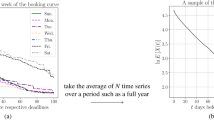Abstract
In this paper, we propose a multivariate time series model for sales count data. Based on the fact that setting an independent Poisson distribution to each brand’s sales produces the Poisson distribution for their total number, characterized as market sales, and then, conditional on market sales, the brand sales follow a multinomial distribution, we first extend this Poisson–multinomial modeling to a dynamic model in terms of a generalized linear model. We further extend the model to contain nesting hierarchical structures in order to apply it to find the market structure in the field of marketing. As an application using point of sales time series in a store, we compare several possible hypotheses on market structure and choose the most plausible structure by using several model selection criteria, including in-sample fit, out-of-sample forecasting errors, and information criterion.
Similar content being viewed by others
References
Cargnoni C., Muller P., West M. (1997) Bayesain forecasting of multinomial time series through conditionally Gaussian dynamic models. Journal of the American Statistical Association 92: 640–647
Carter C.K., Kohn R. (1994) On Gibbs sampling for state space models. Biometrika 81: 541–553
Colombo R.A., Morrison D.G. (1989) A brand switching implications for marketing strategies. Marketing Science 8: 89–99
Grover R., Dillon W.R. (1985) A probabilistic model for testing hypothesized hierarchical market structures. Marketing Science 4: 312–335
Grover R., Srinivasan R.V. (1987) A simultaneous approach to market segmentation and market structuring. Journal of Marketing Research 24: 139–153
Hanssen D.M., Parsons L.J., Shultz R.L. (2001) Market response models: econometric and time series analysis (2nd ed). Kluwer, Boston, MA
Harvey A.C., Fernandes C. (1989) Time series models for count or qualitative observations. Journal of Business and Economic Statistics 7: 407–422
Kamakura W., Wedel M. (2000) Market segmentation—conceptual and logical foundations (2nd ed). Kluwer, Boston
Lambert D. (1992) Zero-inflated Poisson regression, with application to defects in manufacturing. Technometrics 34: 1–14
Lilien G.L., Rangaswamy A. (2003) Marketing engineering. Prentice Hall, New Jersey
Lilien G.L., Kotler P., Moorthy K.S. (1992) Marketing models. Prentice Hall, New Jersey
McCullagh P., Nelder J.A. (1990) Generalized linear models (2nd ed). Chapman & Hall, London
Ord K., Fernandes C., Harvey A. C. (1993) Time series models for multivariate series of count data. In T. Subba Rao (Ed.), Developments in time series analysis (pp. 295–309). London: Chapman & Hall
Spiegelhalter D.J., Best N.G., Carlin B.P., van der Linde A. (2002) Bayesian measures of model complexity and fit. Journal of the Royal Statistical Society Series B 64: 583–639
Urban G.L., Johnson P.L., Hauser J.R. (1984) Testing competitive market structures. Marketing Science 3: 83–112
West M., Harrison P.J. (1989) Bayesian forecasting and dynamic models. Springer, New York
West M., Harrison P.J., Migon H.S. (1985) Dynamic generalized linear models and Bayesian forecasting. Journal of the American Statistical Association 80: 73–97
Author information
Authors and Affiliations
Corresponding author
Additional information
Terui acknowledges the financial support of by the Japanese Ministry of Education Scientific Research Grants (C)18530152. The authors thank the associate editor and three anonymous reviewers for their helpful comments.
About this article
Cite this article
Terui, N., Ban, M. & Maki, T. Finding market structure by sales count dynamics—Multivariate structural time series models with hierarchical structure for count data—. Ann Inst Stat Math 62, 91–107 (2010). https://doi.org/10.1007/s10463-009-0244-2
Received:
Revised:
Published:
Issue Date:
DOI: https://doi.org/10.1007/s10463-009-0244-2




